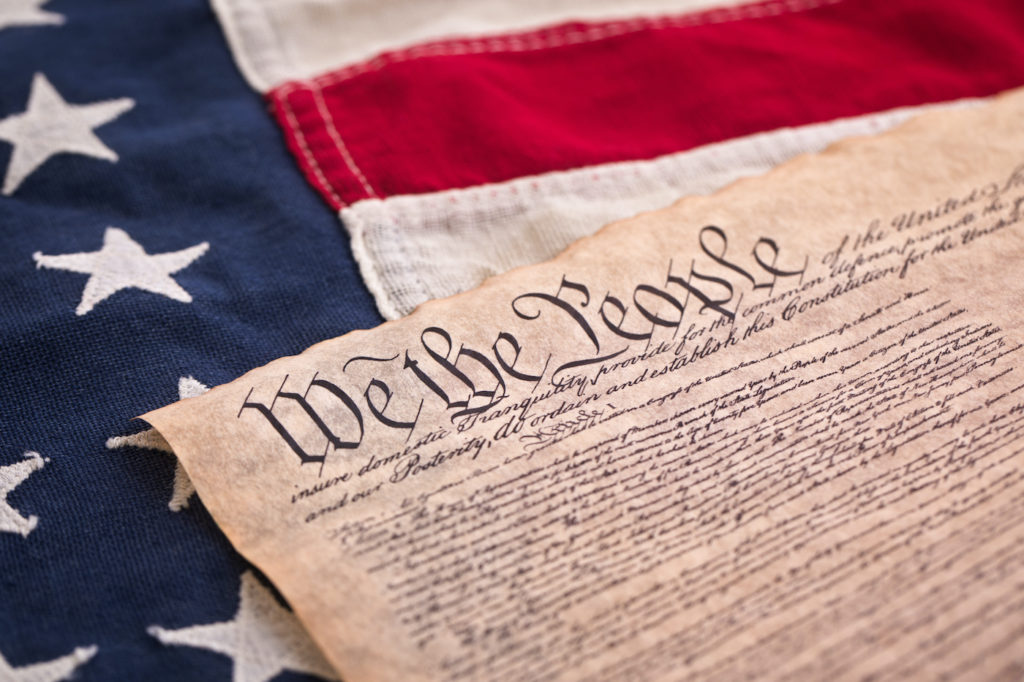This essay is part of a week-long series drawn from the Witherspoon Institute’s project on Natural Law, Natural Rights, and American Constitutionalism. Click here to read PD Editor-in-Chief R.J. Snell’s introduction to the series.
It is not always appreciated that the U.S. Constitution was preceded by fifteen state constitutions and that many delegates to the federal convention participated in this state constitution-making process and drew heavily on and presumed the continued vitality of these state documents. In order to understand the role of natural law in the American founding, it is helpful to examine these early state constitutions. Not only did many of them explicitly recognize natural rights as pre-political rights to which all individuals are entitled, they also proclaimed all political power to be inherent in the people, governments to be legitimate only insofar as they secure these rights and are grounded in popular authority, and, therefore, that the people have an inalienable right to reform or abolish such governments that fail or cease to serve these ends. In short, the principles expressed in the Declaration of Independence were enshrined, and occasionally expanded upon, in the founding-era state constitutions that provided the context and model for the federal constitution.
Constitution-Making in the Founding Era
When the 55 delegates assembled at the federal constitutional convention in 1787, they drew on more than a decade of experience with American constitution-making, as states had already grappled with such questions as what a constitution should contain and how it should be enacted. In January 1776, New Hampshire was the first state to adopt a constitution, as opposed to the charters under which colonies had previously been governed. However, this was only intended to be a temporary constitution, as were the constitutions of South Carolina and New Jersey adopted in the next several months. In June of the same year, Virginia was the first state to enact a constitution intended to be an enduring document, and all of the state constitutions drafted thereafter were similarly intended to be enduring charters. Virginia was also the first state to adopt a separate declaration of rights, and an earlier draft of this document circulated widely among the states and exerted a significant influence on the Declaration of Independence promulgated the next month. In June 1780, Massachusetts became the first state to adopt a constitution that was drafted by delegates elected specifically for this purpose and ratified by the people; this process of popular ratification would thereafter be followed by most other state-constitution-makers as well as the framers of the U.S. Constitution.
Start your day with Public Discourse
Sign up and get our daily essays sent straight to your inbox.As mentioned, states adopted 15 constitutions prior to 1787. Most states adopted a single constitution during this period, as was the case with New Jersey (1776), Virginia (1776), Delaware (1776), Pennsylvania (1776), Maryland (1776), North Carolina (1776), New York (1777), Georgia (1777), and Massachusetts (1780), which is the only founding-era state constitution to endure to this day and the oldest current constitution in the world. However, several states adopted multiple constitutions, including South Carolina (1776, 1778) and New Hampshire (1776, 1784), as well as Vermont (1777, 1786), which did not enter the union until 1791. Of the original thirteen states, only Connecticut and Rhode Island failed to adopt founding-era constitutions; they retained their colonial charters until 1818 and 1842, respectively.
It is estimated that as many as one-half of the delegates to the federal convention participated in the framing of these state constitutions, and the influence of these state constitutions on the work of the convention was proclaimed even by individuals who were not present in Philadelphia in 1787. John Adams, the principal drafter of the Massachusetts Constitution of 1780, boasted, “What is the Constitution of the United States . . . but that of Massachusetts, New York, and Maryland! There is not a feature of it which can not be found in one or the other.”[1]
The Reliance on Natural Law and Natural Rights in State Constitutions
Founding-era state constitutions frequently relied explicitly on the natural law principles enshrined in the Declaration of Independence. Admittedly, states differed in their willingness to invoke these principles, with some states, such as South Carolina, Georgia, New Jersey and New York, declining to make explicit reference to “natural” or “inherent” or “inalienable” rights. States also differed in the particular wording they used to express these principles. What stands out from a review of the totality of the founding-era state constitutions, however, is the repeated reliance on natural law principles and widespread understanding that individuals are entitled by nature to the enjoyment of certain rights, have an inherent right to live under a republican government, and possess an inalienable right to reform or abolish governments that fail to secure these rights or operate with the consent of the governed.
A number of founding-era constitutions opened with provisions declaring the natural rights that all individuals possess prior to formation of the social compact. The states that included such provisions were remarkably consistent in mentioning life, liberty, property, happiness, and safety in the list of foundational natural rights (in this sense, the Declaration of Independence is the outlier in founding-era documents in including only life, liberty, and happiness). The Pennsylvania Constitution of 1776 is typical. The first substantive provision after the preamble stated: “That all men are born equally free and independent and have certain natural, inherent and inalienable rights, amongst which are, the enjoying and defending life and liberty, acquiring, possessing and protecting property, and pursuing and obtaining happiness and safety.” In fact, Vermont constitution-makers were explicit about the universality of this principle and its application to slavery. After stating verbatim the principle above from the Pennsylvania Constitution, the Vermont Constitution of 1777 proceeded to draw out its implications, declaring: “Therefore, no male person, born in this country, or brought from over sea, ought to be beholden by law, to serve any person, as a servant, slave or apprentice, after he arrives to the age of twenty-one years, nor female, in like manner, after she arrives to the age of eighteen years, unless they are bound by their own consent, after they arrive to such age, or bound by law, for the payment of debts, damages, fines, costs, or the like.”
In addition to including these foundational declarations of natural rights, state constitutions were at times explicit about the natural-rights grounding of other liberties. Not all rights were grounded in natural law principles, as these state constitutions made clear. Freedom of speech and press, trial by jury, protection against unreasonable searches, and the right to bear arms were several of the various rights that were protected in founding-era constitutions but were not grounded explicitly in natural law principles, as when the North Carolina Constitution of 1776 stated “That the freedom of the press is one of the great bulwarks of liberty, and therefore ought never to be restrained.”
Certain rights were clearly recognized as natural and inalienable, especially religious freedom, as when the North Carolina Constitution proclaimed: “That all men have a natural and inalienable right to worship almighty God according to the dictates of their own consciences.” The New Hampshire Constitution of 1784 provided the most sustained explanation of the status of natural rights and the natural-rights basis of religious liberty. Immediately after providing a standard statement about the natural rights to life, liberty, property, and happiness, the New Hampshire Constitution went on to explain: “When men enter into a state of society, they surrender up some of their natural rights to that society, in order to insure the protection of others; and, without such an equivalent, the surrender is void.” This was then followed by a provision to the effect that, “Among the natural rights, some are in their very nature inalienable, because no equivalent can be given or received for them. Of this kind are the RIGHTS OF CONSCIENCE.”
Interestingly, the right to emigrate was another right occasionally grounded in natural law principles. According to the Pennsylvania Constitution of 1776: “[A]ll men have a natural inherent right to emigrate from one state to another that will receive them, or to form a new state in vacant countries, or in such countries as they can purchase, whenever they think that thereby they may promote their own happiness.”
Several founding-era constitutions were also explicit about the inherent right of the people to enjoy a republican form of government. The New Hampshire Constitution of 1784 opened by declaring: “All men are born equally free and independent; therefore, all government of right originates from the people, is founded in consent, and instituted for the general good.” In a similar vein but employing slightly different language, the Pennsylvania Constitution of 1776 stated: “That all power being originally inherent in, and consequently derived from, the people; therefore, all officers of government, whether legislative or executive, are their trustees and servants, and at all times accountable to them.”
Finally, and flowing from the understanding that individuals possess natural rights and cannot be governed without their consent, many founding-era constitutions recognized an inalienable right of the people to reform or abolish governments that failed to secure these rights or act for the common benefit. The Massachusetts Constitution of 1780 was typical in making clear that “the people alone have an incontestible unalienable, and indefeasible right to institute government; and to reform, alter, or totally change the same, when their protection, safety, prosperity, and happiness require it.”
Natural-law principles did not provide the sole guidance for founding-era constitution-makers. They also drew on the rights of Englishmen as set out in the Magna Carta and Bill of Rights of 1689, as well as conceptions of popular sovereignty developed through experience of colonial governance. Nevertheless, there is no mistaking the strong influence of natural-law principles on the founding-era state constitutions that provided the context and in many respects served as models for the federal constitution.














